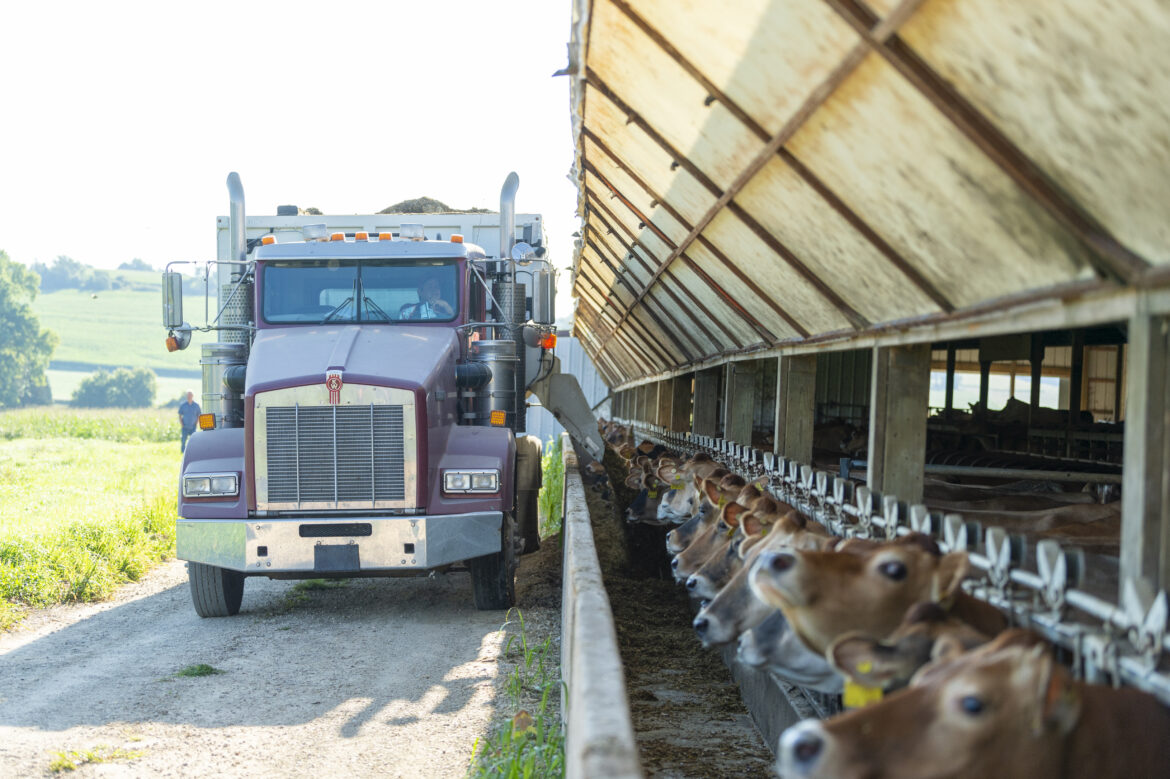Throughout the COVID-19 pandemic, the American agriculture industry experienced enormous losses from supply chain and market disruptions.
In response, Wisconsin’s agriculture industry focused on implementing new community-focused programs such as cost-share programs and Dairy Recovery programs to address supply chain and market issues.
According to the Council of Economic Advisers, when the pandemic first hit, agricultural organizations and farmers dealt with price increases and limited product availability, which continue to persist. Wisconsin agriculture has made significant progress but still carries many of the negative effects of the pandemic despite numerous recovery efforts.
A strong recovery post-pandemic is vital for Wisconsin’s economy to continue to grow. Throughout Wisconsin, agriculture is a $104.8 billion industry and provides more than 435,000 jobs, according to the University of Wisconsin–Madison Division of Extension. If agriculture struggles, billions of dollars and thousands of jobs are at risk.
Since the pandemic’s supply chain and market disturbances affected virtually all agricultural businesses in Wisconsin, collective solutions became essential to survive. Immediate state intervention and assistance were critical for Wisconsin’s agriculture industry.
According to Randy Romanski, the secretary of the Department of Agriculture, Trade and Consumer Protection, the agency had regular communication with the agriculture industry to see which problems emerged. Collective work with the state and agriculture organizations to “connect the dots” were necessary to address supply chain issues.
Community-driven programs flourished
Implementation of programs such as the Cost-Share program, Dairy Recover program, Food Security program and Farm Neighbors Care brought the agriculture community together and provided significant progress during the pandemic.
Yahara Pride Farm — a 501(c)(3) nonprofit organization founded in 2012 that focuses on conservation throughout Wisconsin — created a Cost-Share program that allows farmers to test new innovative conservation technologies, a demonstration of how strong agriculture programs established before the pandemic flourished throughout it.
“Our Cost-Share Program, where we work directly with farmers, actually grew during COVID-19,” said Jeff Endres, chair of the Yahara Pride Farms board of directors. “Since farmers were essential workers, farmers kept farming from day one. Our Cost-Share program kept moving forward, and we actually were more effective with conservation on the farm fields and soil health.”
Farmers’ classification as essential workers allowed agricultural organizations to remain open when many other businesses closed. The state recognized this and had to focus on the implementation of unique and creative programs such as the Dairy Recovery program, which helped with the purchasing, processing and distribution of milk to solve supply chain issues in a collective manner.
During the start of the pandemic, dairy farmers could not sell to consumers in time and had to dump their milk. The Dairy Recover program stepped in and helped these farmers.
“When we saw the first round of supply chain disruption there was milk disposal going on... The Dairy Recovery program found a way to buy milk that would otherwise have been disposed of and processed that milk for food consumption,” Romanski said. “The Hunger Task Force worked to make sure those farmers were getting a fair price for the milk.”
According to Romanski, The Dairy Recovery program worked with other processors and organizers throughout Wisconsin, including the Hungry Task Force and Dairy Farmers of Wisconsin.
Another program that significantly helped farmers during the pandemic was the Food Security program. This program allocated $65 million in federal funds to Wisconsin’s agriculture industry and food-insecure residents. It was more evidence that working together through programs helped the agriculture industry persevere during supply chain struggles.
“In order to [implement the Food Security program], DATCP does not have those kinds of connections with all the local food pantries to make [the Food Security program] work,” Romanski said. “We created a partnership with Feeding Wisconsin and the Hunger Task Force, the two largest food support programs in Wisconsin, to connect food insecure households and Wisconsin farmers.”
The Food Security program was able to fulfill the need to keep the supply chain stable through access to local products. Endres echoed the importance of programs that pushed local product consumption during the pandemic.
“I think one of the things that we hopefully learn from this is that we have let our local industry go as far as supplying the public with products,” Endres said. “We probably need to get back to more local processing facilities for [Wisconsin’s] food chain.”
The Wisconsin Farm Bureau Federation — the largest farm organization in Wisconsin that serves as a voice for farmers — worked with numerous farmers and agriculture organizations throughout the pandemic. They also effectively implemented community-driven programs to help mitigate the negative effects.
Farm Neighbors Care was a social media campaign employed by the Wisconsin Farm Bureau Federation that helped support Wisconsin farmers who were facing stress from supply chain and market issues.
According to Beth Schaefer, the Wisconsin Farm Bureau Agriculture in the Classroom coordinator, Farm Neighbors Care occurred in counties across Wisconsin and included people, communities, agriculture and non-agriculture groups coming together to talk and highlight the importance of being connected to each other.
These conversations were not just about isolation and lockdown but also focused on the type of isolation that can occur in rural areas, especially for those who were not in Zoom meetings every day.
“Farm Neighbors Care did some really amazing work throughout COVID-19 as far as sending care packages and providing training which has led to ongoing programming,” Schaefer said. “There are coffee chats, virtual coffee chats for women in agriculture. There is training about mental health and recognizing how to find those resources whether it be performed through Farm Care of the Wisconsin Farm Center.”
Post-pandemic outlook
Now that it has been almost two years since the start of the COVID-19 pandemic, many actions from the agriculture industry during the pandemic continue to have positive impacts. Strong continued communication appears to be clear evidence of how to achieve post-pandemic success for agriculture organizations.
“I think the thing that was really positive was that we managed as a board of directors to keep the organization moving forward, viable and growing through probably one of the toughest challenges that you could ever imagine in my lifetime,” Endres said.
Schaefer expressed the importance of unity and taking the lessons learned from the pandemic and applying them today. Unfortunately, communication that was strong during the pandemic has slowly been forgotten.
“I don’t want to say go away, but we have kind of forgotten how great it was to work together,” Schaefer said. “We are trying to capture [working together] by doing more collaborative work. We recognize that there is not enough time, money and talent to have individual initiatives. It has become more important than ever to help consumers understand where food comes from. The pandemic shined a light on the fact that food does not start at the grocery store, that is where it ends up.”
Responsive action and communication continue to be the main focus for DATCP post-pandemic. Reaching out and supplying agriculture organizations with resources is still at the forefront of DATCP’s priorities.
“I think there were a lot of relationships that were either created or strengthened because we had such frequent and ongoing conversations which still occur to this day,” Romanski said. “The most important thing for us is to be a responsive resource to the industry.”
Room for improvement
Yahara Pride Farms had success in many of its programs but saw issues connecting and communicating with the public throughout the pandemic. These problems still occur, and connecting better with the public is something Yahara Pride Farms is working on today, according to Endres.
“We are still having some issues getting to the public, into [virtual] meetings to share our story and successes,” Endres said. “We are still seeing some of these meetings being held with lake enthusiasts and other organizations still online. As we speak today, I think that still is a challenge for us to get in and talk with the concerned citizens and folks around the watershed area.”
There are always more ways to improve and better connect with the agriculture community. The Farm Bureau Federation recognized a need to improve creativity and to take a step outside of their comfort zone.
“I think one thing I wish we could have done differently was to have a bigger imagination,” Schaefer said. “I think we don’t dream and we don’t really think we will be able to truly do the big initiatives. They are not going to happen. So I wish we would have really had more faith and creativity because sometimes we get into our little boxes, and they just don’t work.”
Companies are still experiencing the effects of the increased costs of raw products. Supply chain challenges at the start of the pandemic are still present, and COVID-19 cases are still present, so it is important to continue to work together and connect, Romanski said.
“COVID-19 gave us a shot in the arm to really connect through ways that people were very uncomfortable with,” Schaefer said. “Everyone made it work, and we made it work because we worked together.”





